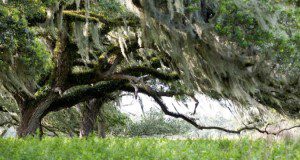This series of Key Plant, Key Pests publications is designed for Florida gardeners, horticulturalists, and landscape professionals to help identify common pests associated with common Florida flora. This new 9-page publication provides information and general management recommendations for borers, caterpillars, insect-induced galls, twig girdlers, oak leaf blister, root and butt rot, Tubakia leaf spot, mistletoe, psocids, lace bugs, woolly aphids, powdery mildew, Spanish and ball moss, and lichens. Written by Juanita Popenoe, Caroline R. Warwick, Adam G. Dale, and Alfred Huo, and published by the UF/IFAS Environmental Horticulture Department.
https://edis.ifas.ufl.edu/ep596
Tag: Oak
Bot Canker of Oak in Florida Caused by Diplodia corticola and D. quercivora
 This 6-page fact sheet describes the emergence of these two pathogens of oak and grapevine in North America and Florida; the signs and symptoms of infection; mechanism of host disease and death; fungal morphology; origin, host range, and classification; and management options. Written by Sonja Mullerin and Jason A. Smith, and published by the UF Department of School of Forest Resources and Conservation, March 2015. (Photo: Jason Smith, UF/IFAS)
This 6-page fact sheet describes the emergence of these two pathogens of oak and grapevine in North America and Florida; the signs and symptoms of infection; mechanism of host disease and death; fungal morphology; origin, host range, and classification; and management options. Written by Sonja Mullerin and Jason A. Smith, and published by the UF Department of School of Forest Resources and Conservation, March 2015. (Photo: Jason Smith, UF/IFAS)
http://edis.ifas.ufl.edu/fr386
FOR250/FR312 Quercus laevis, Turkey Oak
FOR250, a 2-page fact sheet by Michael G. Andreu, Melissa H. Friedman, Mary McKenzie, and Heather V. Quintana, describes native deciduous oak frequenting xeric sand dunes, sandhills, and ridges from Virginia south to central Florida and west to the southeastern portion of Louisiana — scientific and common names, description, allergen, storm tolerance, and applications. Includes references. Published by the UF School of Forest Resources and Conservation, May 2010.
http://edis.ifas.ufl.edu/fr312
FOR249/FR311 Quercus geminata, Sand Live Oak
FOR249, a 2-page fact sheet by Melissa H. Friedman, Michael G. Andreu, Heather V. Quintana, and Mary McKenzie, describes this highly wind-resistant, small, native, evergreen tree found along the coastal plain of Louisiana east to North Carolina and south throughout most of peninsular Florida — scientific and common names, description, allergen, storm tolerance, and applications. Includes references. Published by the UF School of Forest Resources and Conservation, May 2010.
http://edis.ifas.ufl.edu/fr311
FOR248/FR310 Quercus incana, Bluejack Oak
FOR248, a 2-page fact sheet by Melissa H. Friedman, Michael G. Andreu, Heather V. Quintana, and Mary McKenzie, describes this deciduous and native shrub-like tree that frequents the xeric sandy soils of ridges, sandhills, and scrub from Virginia south to Florida and west to Texas and Oklahoma – scientific and common names, description, allergen, and applications. Includes references. Published by the UF School of Forest Resources and Conservation, May 2010.
http://edis.ifas.ufl.edu/fr310
WEC249/UW293 Managing Oaks to Produce Food for Wildlife
WEC-249, a 5-page illustrated fact sheet by Holly K. Ober and Patrick J. Minogue, describes the reasons homeowners should consider planting oaks, how to select the right oak species for a given site, and how to improve wildlife habitat in established stands. Includes references. Published by the UF Department of Wildlife Ecology and Conservation, August 2008.
http://edis.ifas.ufl.edu/UW293
